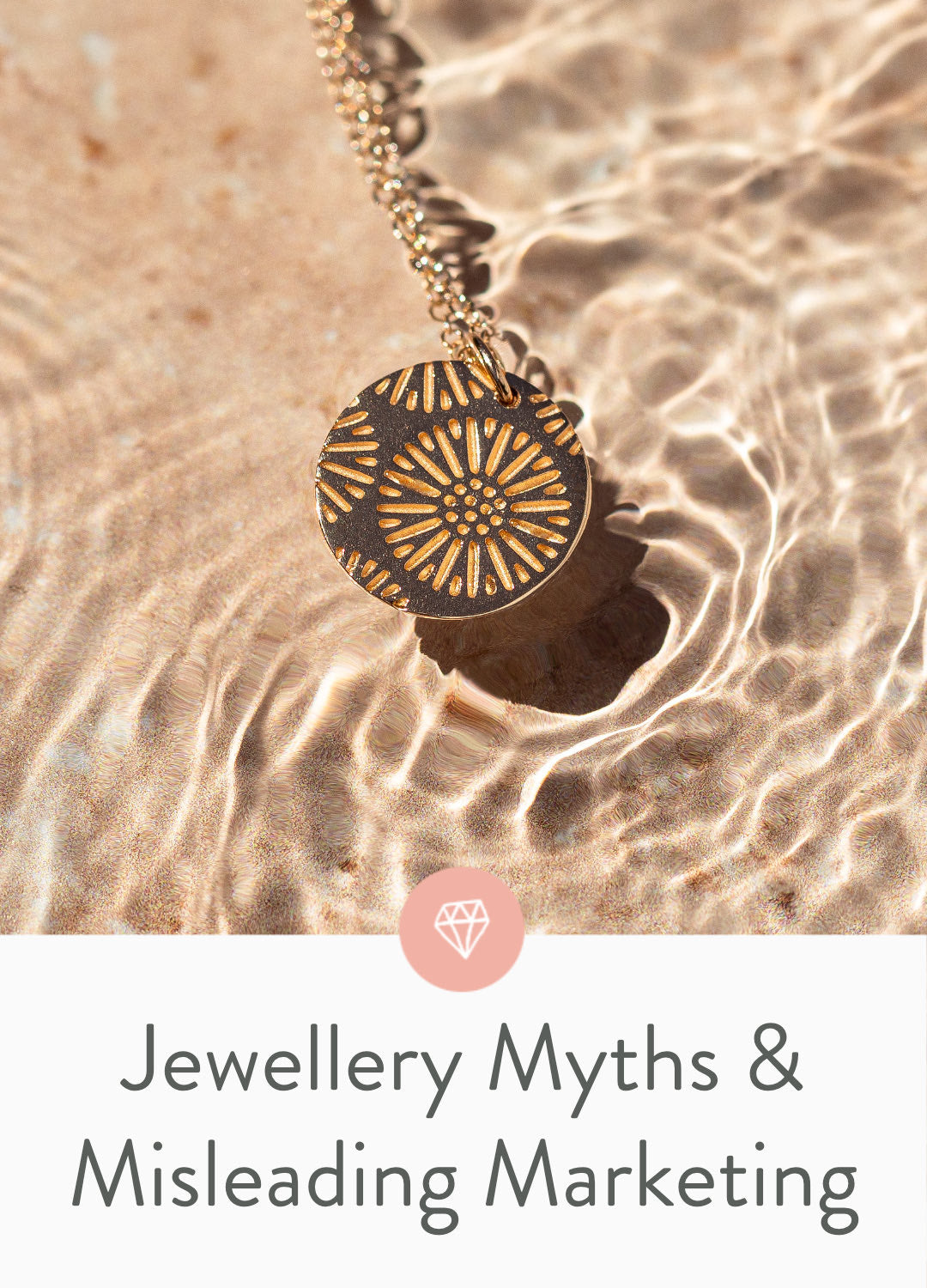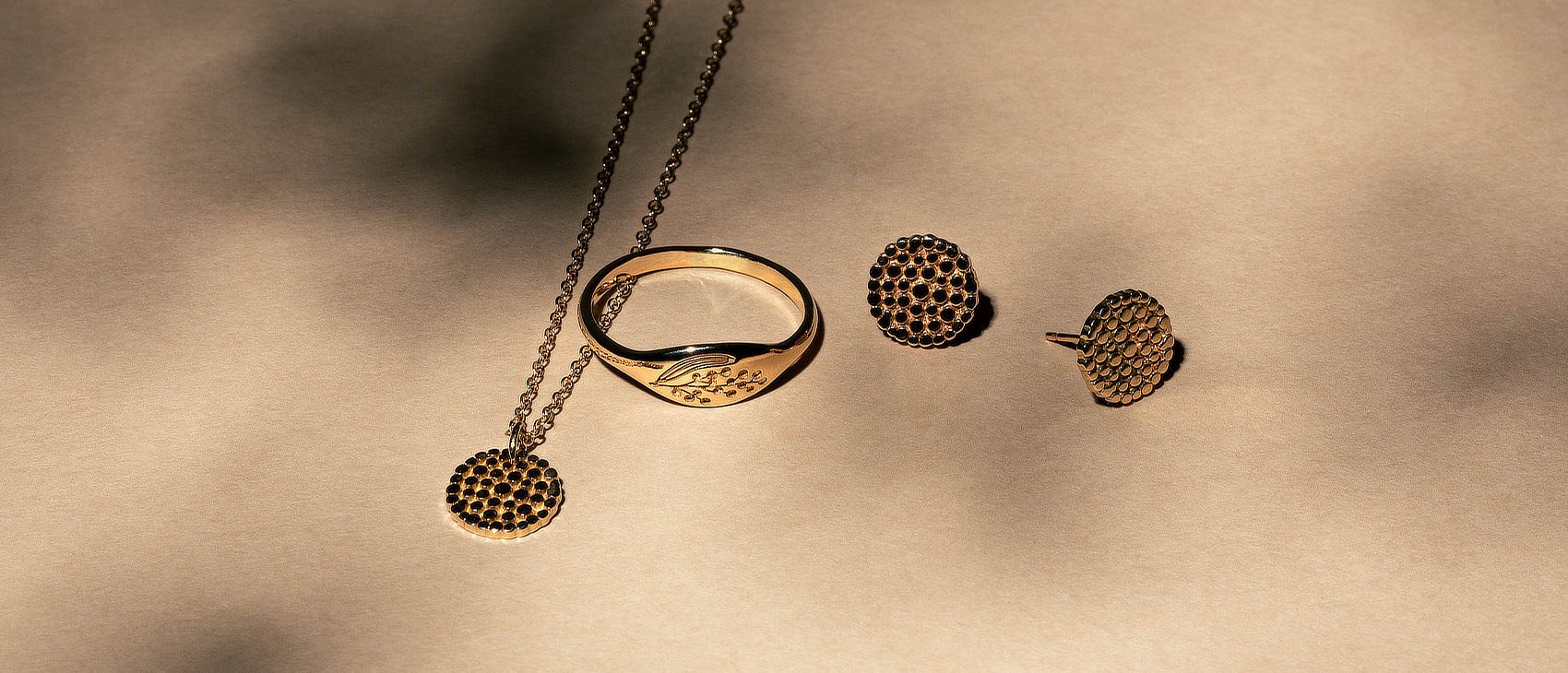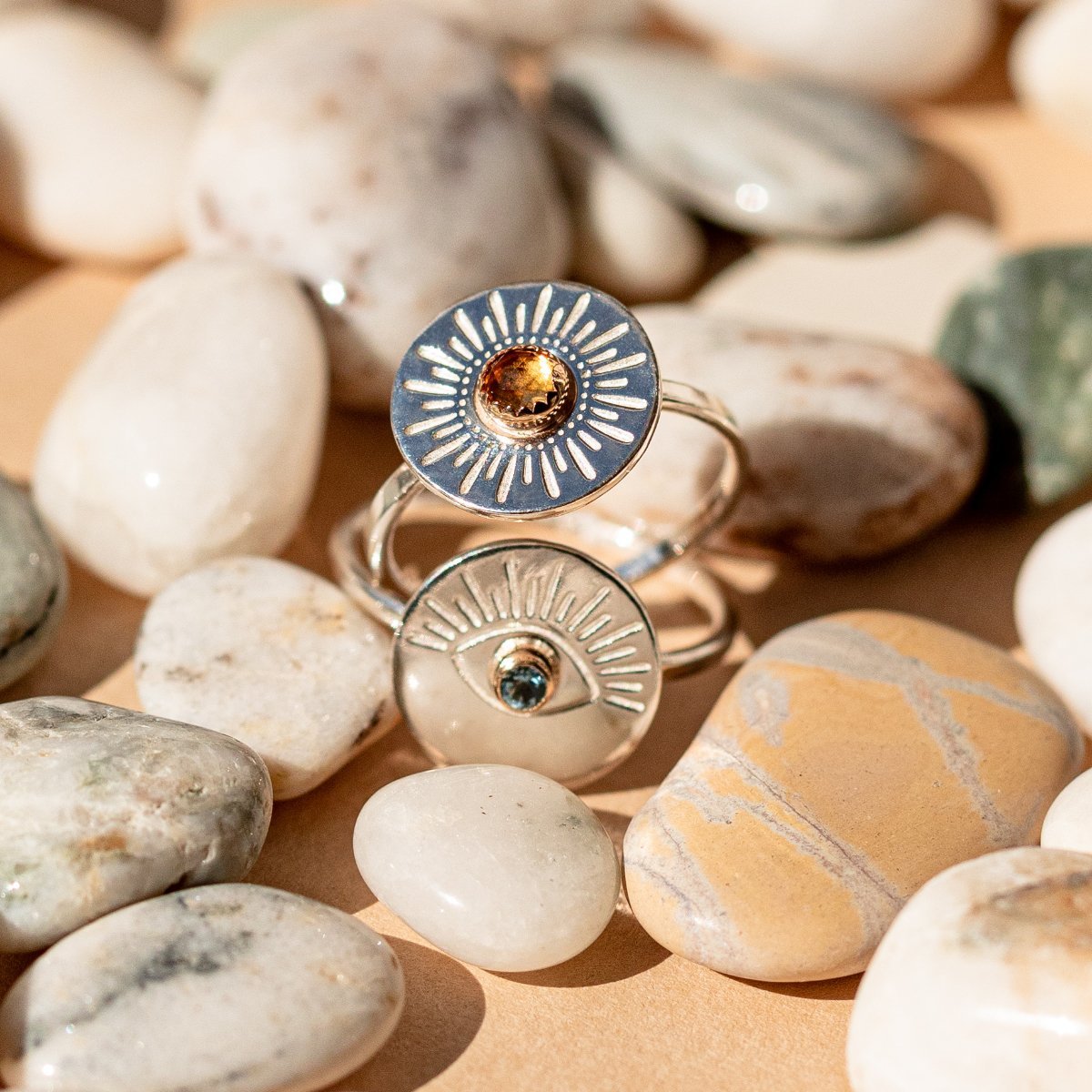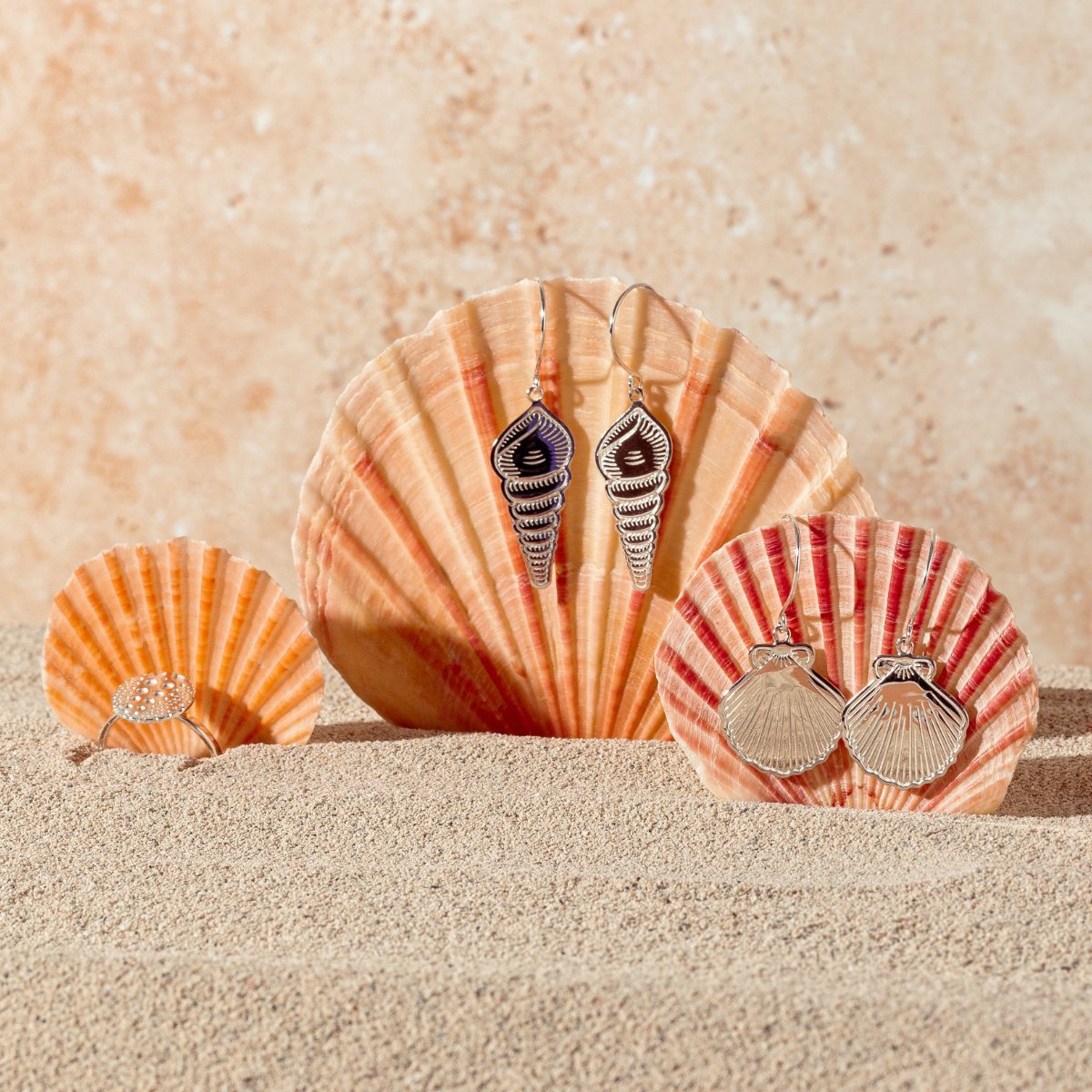 Have you ever seen a jewellery ad that makes big claims ('waterproof', 'sweatproof', 'hypoallergenic', 'tarnish-free', or even 'ethical') and thought, "Wow, that sounds too good to be true"? Well, unfortunately often it really is.
Have you ever seen a jewellery ad that makes big claims ('waterproof', 'sweatproof', 'hypoallergenic', 'tarnish-free', or even 'ethical') and thought, "Wow, that sounds too good to be true"? Well, unfortunately often it really is.
I truly, madly and deeply want you to make good choices when you're shopping for jewellery. But I also know that there's a lot of misleading jewellery marketing out there. As a professional with decades of experience in creating jewellery, this is easy for me to spot, but that's less the case for a non-professional.
This article was written because I want to help you be well informed so that you can much more easily spot these misleading claims.
It breaks down some of the most misleading terms you'll see used in jewellery marketing. I hope it helps you to shop smarter, make informed choices, and steer clear of hype that doesn’t really hold up.
So let’s dive in and bust some myths!
Waterproof Jewellery
Ever seen jewellery marketed as waterproof ... only to find the brand advises you in the small print to avoid water, chemicals, and humidity? Yep — I've seen this too.
Here’s the reality: no jewellery is truly waterproof. Most metals, including precious ones, will eventually be affected by water, especially if it contains salt, chlorine, or other chemicals (and let’s be honest, most water does).
Precious Metals
Solid silver and gold are generally resilient, but they're not invincible. Both are alloyed with other metals to make them durable enough for jewellery — and it’s these alloyed metals that can corrode over time.
Occasional exposure (like casual swims or showers) is unlikely to ruin your jewellery. But regular, prolonged contact? That can lead to pitting, dullness, and damage — especially in chlorinated or salty water, or if you're using soaps, shampoos and other chemicals.
If you wear plated jewellery, you need to be even more careful. Water will wear down the thin layer of precious metal, exposing the base metal underneath. We don't recommend regular plated jewellery: the savings are almost never worth it.
Stainless Steel & Titanium
These metals are more corrosion-resistant, but even they aren’t immune to long-term exposure to chemicals or moisture. It's still smart to take them off before diving into the ocean or daily showers.
Gemstone Jewellery
Soft or porous gemstones such as in opal jewellery and pearl jewellery don’t play well with water either. Know your stones and treat them with care.
PVD Coatings
Some brands use PVD (physical vapour deposition) coating, which creates a strong, water-resistant layer on metal. It’s legit, but it's not flawless and comes with its own downsides.
PVD can make jewellery difficult (even impossible) to repair, it will eventually wear through, and it tends to be used on non-precious metals. Because it's an expensive process, you will end up paying above the odds for jewellery which may have little or no intrinsic value.
The Bottom Line
Water-resistant? Sometimes. Waterproof? Not really. Be sceptical of such claims and look closer at the details.
See our Jewellery Care & Cleaning Guide for more tips about jewellery and water.
Sweat Proof Jewellery
'Sweatproof' sounds promising, but as a marketing term it’s just as problematic as 'waterproof'. And I think it would be kind of pointless, even if it were real!
Sweat contains salts, acids, and other substances that can tarnish or corrode metal. Some people’s sweat reacts strongly with certain metals, especially silver. Sweat can also leave a residue or even damage certain gemstones - especially pearls.
Platings or coatings (like rhodium or PVD as above) can help, but they wear off over time — especially in high-friction areas like fingers or wrists.
The Bottom Line
If you’re planning a workout or will be sweating a lot, it’s best to take your jewellery off first. If you choose to leave it on, then it will get covered in sweat - even if it does have a protective coating - and surely you'll want to clean it anyway.
Hypoallergenic Jewellery
'Hypoallergenic' is a term that sounds reassuring, but did you know it's purely a marketing term? It's supposed to indicate a lower allergy risk, but as a term it has no clear definition and it's not regulated or standardised in Australia, US or elsewhere.
Research indicates that many so-called 'hypoallergenic' products actually contain common known allergens. Some brands will even lead you to believe that 'hypoallergenic' means there's zero risk of allergic reactions for anyone, which is often not possible.
What about 'hypoallergenic' as it's applied to jewellery? Well, as you might have guessed, it's problematic.
Nickel
Nickel is the most common cause of jewellery allergies. Around 17% of women and 3% of men are allergic to it. It’s sometimes used to harden gold or create white gold, and is often seen in costume jewellery.
If you're not allergic to nickel, that doesn't mean won't become so: a nickel allergy can start at any time and there is no curing it. The best thing you can do is avoid having nickel against your skin as much as you can and avoid the allergy starting.
At Simone Walsh Jewellery, we only use nickel-free metals. Always double-check that jewellery is nickel free — especially stainless steel and white gold, which can often contain it.
Also avoid anything labelled 'nickel silver' or 'German silver': it contains no silver at all - just nickel.
Other Metals
Even metals like titanium, platinum and palladium can cause reactions in some people - in spite of the 'hypoallergenic' claims you might encounter in jewellery marketing.
While precious metals are less likely to cause allergic reactions than base metals, silver and gold are not hypoallergenic either. Some people are allergic to silver, most commonly due to the copper content found in sterling silver. Gold allergies are very rare, but not at all impossible.
The Bottom Line
There is no special form of metal which will make one brand's jewellery less likely to cause allergies than another. So be very wary of vague 'hypoallergenic' labels: for the most part they are meaningless.
If you have metal sensitivities, talk to your doctor and learn which metal is the issue. Always ask for a full list of metals used in jewellery - and especially avoid nickel, even if you're not currently allergic to it.
Just to re-assure you: all of our Australian made jewellery is nickel free.
Tarnish-Free Jewellery
'Tarnish-free' is another feel-good term that’s often misleading - especially when used to describe silver.
Silver Tarnish
Almost all silver jewellery is made from sterling silver (an alloy of 92.5% silver, 7.5% copper), which can - and does - tarnish when exposed to moisture or chemicals. But it’s easy to clean, especially if you keep on top of it.
Some silver jewellery may be rhodium plated to resist tarnish—but the plating wears off and needs replacing. It also has a slightly different, cooler colouring to real silver.
PVD Coatings
PVD coating (as outlined above) can also resist tarnish and will last longer than rhodium. But these finishes are still not permanent and are most often used in mass-produced, non-precious pieces.
The Bottom Line
If you want truly tarnish-resistant jewellery, choose solid gold, platinum, titanium, or stainless steel. If you’re buying silver jewellery labelled as 'tarnish-free', look into what is behind this claim and understand its pros and cons.
Cleaning silver jewellery is easy. Read our guide: How to Properly Clean Silver Jewellery to get the lowdown.
Ethical & Sustainable Jewellery
Ethical and sustainable jewellery is of course important, but some brands use those words as pure marketing fluff.
If there’s no backstory, sourcing information, or transparency around materials and packaging, then be sceptical. These claims should come with receipts.
At Simone Walsh Jewellery, we genuinely commit to sustainability and ethics because we actually do want to do the very best we can in these areas. Learn more about our ethical & eco-friendly jewellery.
The Bottom Line
Look for transparency and evidence. If a brand says they’re ethical or sustainable, they should explain how and why. If it’s all buzzwords and no detail, it’s time to look elsewhere.
Greenwashing is absolutely a thing and we all stand to benefit if it goes away.
(Reading this on a website that isn't simonewalsh.com? Be aware that the content has been stolen, infringing the copyright of a small business. ABN: 65108844126)
Wrapping Up
Other Jewellery Tips:
Buzzwords like 'waterproof', 'hypoallergenic', 'tarnish-free', and 'ethical' can sound impressive and like they solve all sorts of problems, but they’re often used without real substance.
If something sounds too good to be true, ask questions and do a little digging. A bit of time spent doing some research will pay you back.
If a seller is not being up front about the materials used in their jewellery or doesn't provide any information to back up unusual claims being made about it, then my advice is to shop elsewhere. You deserve jewellery that lives up to its promises.
For more helpful tips also see our guide to How to Buy Jewellery Safely Online.
Happy (and safe) jewellery shopping! And if you’re looking for beautiful, handmade and honestly described pieces, check out our Jewellery Shop Australia.






 Simone Walsh is a
Simone Walsh is a 
